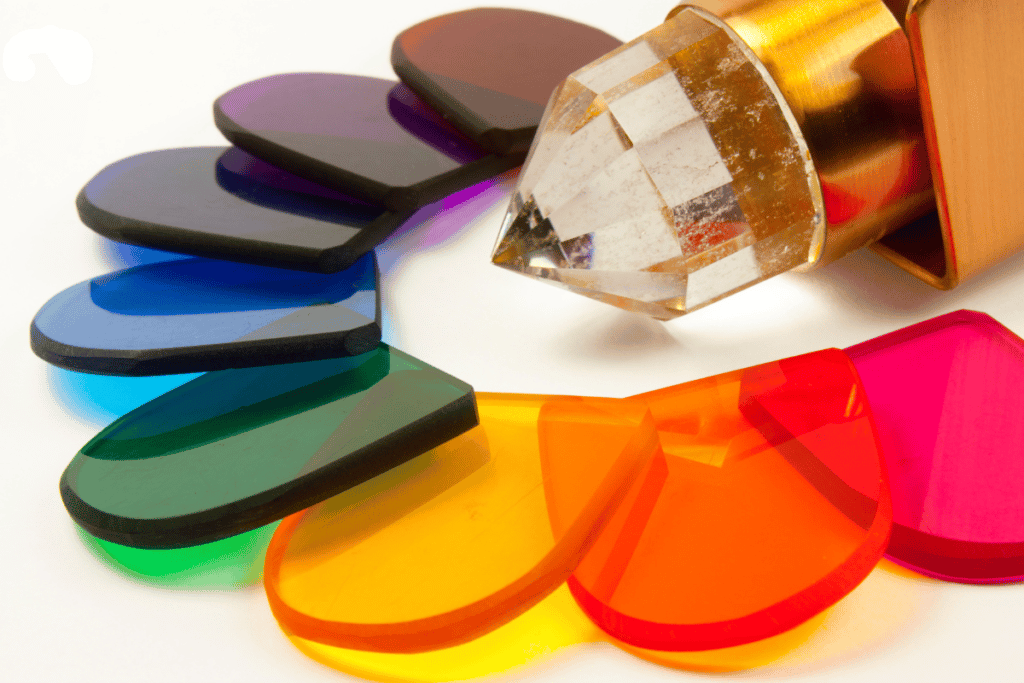Sauna chromotherapy is just starting to get the recognition it deserves. Our goal is to provide you with a comprehensive guide, so you have a good grasp of this new development. After this article, you may even want to try it out yourself!
Infrared sauna colors (chromotherapy) can potentially help anxiety, aggression, cognitive function, and more. Red light is used to help treat cancer, while blue light is well-known to be a soothing color. Pink light can ease aggression, and orange light can help stimulate your prefrontal cortex.
Keep reading to learn all about this fascinating science!
What is sauna chromotherapy?
Unless you’re a major sauna nerd, you likely haven’t heard of sauna chromotherapy. That’s where we come in!
Sauna chromotherapy is the utilization of chromotherapy in infrared saunas. Chromotherapy (using different colors of light) is a great way to help treat certain health conditions such as depression, anxiety, anger, aging skin, and possibly even cancer.
Sauna chromotherapy is the technique of using colors of electromagnetic radiation to treat health conditions. Chromotherapy is utilized in infrared saunas using LED lights that can change colors.
Using chromotherapy in the sauna can boost the already-therapeutic properties of the sauna to a whole new level. Similarly, personalizing the color of light used based on the needs of the sauna-goer creates an unparalleled sauna experience.
The science behind chromotherapy

Chromotherapy has a complicated science, so let’s break it down.
Chromotherapy uses the vibrations within light to activate or inhibit your brain’s physiological, biological, and biochemical processes. Every organ, cell, and atom in your body vibrates at a specific frequency. When that frequency gets out of balance, chromotherapy can help balance it again.
While chromotherapy has legitimate health benefits, the following is the best explanation for chromotherapy without going into how each health benefit works.
The first basis of chromotherapy is that light is energy. The energy frequency differs for each color of the visible (and nonvisible) light spectrum. This is something you likely discussed in middle school!
To best understand chromotherapy, think about using energy fields in light to interact with energy fields in our body in a complex manner.
Chromotherapy stands on the premise that each organ, cell, and atom in our body has its own unique vibrational energy. When a part of the body deviates from its typical vibration, it becomes diseased or stops working correctly.
When this occurs, chromotherapy works to balance these vibrations back to what they should be. It accomplishes this by activating or inhibiting the physiological, biological, and biochemical processes in your brain.
We would be remiss not to mention that chromotherapy is reminiscent of the ancient belief in chakras practiced by Hinduism, Tantric Buddhism, and New Age followers.
Who could benefit from chromotherapy?
Chromotherapy can help with a wide range of conditions.
Many people could benefit from chromotherapy, including people with anxiety and depression, jetlag, seasonal affective disorder, anger, aging skin or skin problems, brain fog, cancer, and more!
People with the following conditions could benefit from chromotherapy:
- Anxiety and depression
- Jetlag
- Seasonal affective disorder
- Anger
- Aging skin or skin problems
- Brain fog
- Cancer
And more are being studied every day!
Who should avoid chromotherapy?
On the other hand, some people should steer clear of this therapy.
People with certain conditions should avoid chromotherapy. For example, people with light sensitivities should avoid white light, while people with anger problems should avoid red light. People who are irritable should avoid yellow light, and people with schizophrenia should avoid chromotherapy in general.
Certain conditions warrant staying away from chromotherapy.
For example, you should avoid bright white light if you have light sensitivities.
If you struggle with anger, red light therapy is likely not a good idea because red can cause aggression in some people.
Likewise, since yellow is so stimulating, people who are irritable or overly energized will likely not fare well using yellow light therapy.
Lastly, people with schizophrenia may be triggered by chromotherapy.
What is the difference between chromotherapy and red light therapy?
Even if you haven’t heard of chromotherapy, you’re more likely to have heard of red light therapy. So what’s the difference?
Red light therapy is a kind of chromotherapy that utilizes red light. This therapy uses low-wavelength red light, and it’s known to reduce signs of aging in the skin. It’s also used in photodynamic therapy, where the red light activates photosensitizing medication.
Simply put, red light therapy falls within the category of chromotherapy. It’s just specific to red light.
RLT uses low-wavelength red light to supposedly improve the appearance of your skin, along with other medical conditions. RLT started as a NASA experiment to see if it could stimulate plant growth and help heal astronauts’ wounds in space.
At this point, it’s widely accepted in its use in photodynamic therapy. Photodynamic therapy is the process of using a combination of photosensitizing medication, along with light energy, to treat things such as:
- Acne
- Infections
- Psoriasis
- Cancer
- And more!
What do the different colors mean in an infrared sauna?

As previously mentioned, different colors help with different things in chromotherapy.
Different colors mean different things in an infrared sauna. For example, red light can help your skin build collagen. Meanwhile, blue light can help with anxiety, eating disorders, and depression. Orange light helps enhance brain activity.
Let’s talk about each color a little bit more in-depth.
Red
Red light is proven to help build collagen in the skin.
The color red is associated with anger and should not be used for mental health disorder treatment.
In addition, photodynamic therapy is when red light is used to activate certain agents in medications.
Orange
Orange can enhance brain activity related to alertness and cognition. This is great for people who are aging or have ADHD.
Yellow
Yellow light was used by Edwin Babbitt as a laxative and to help with bronchial difficulties. It’s impossible to know whether this worked or not.
Yellow is also stimulating emotionally and should perhaps not be used in the context of someone who has anger or anxiety problems.
However, it may be helpful for people with fatigue or ADHD.
Green
It’s not a large leap to make that most of the forest is green! It’s easy to theorize that the color green is partially responsible for these results.
It makes sense that green would improve moods. Humans have evolved to be drawn to the color green because it symbolizes food and shelter.
Blue
Blue is a soothing color. Likewise, it was also reported in the American Association for the Advancement of Science that it could help with eating disorders, depression, and addiction.
It is also supposedly effective at healing injured tissue, burns, and lung conditions.
Purple
Purple was originally the color of royalty due to how hard it was to acquire purple gemstones and paint.
The psychology of the color purple is supposedly power, luxury, and wisdom. This is why brands choose the color purple in their logos. A purple chromotherapy session may leave you feeling confident.
Lighter tones of purple, like lavender, are also known to be calming, just like blue.
Pink
Pink glasses are widely used in therapeutic environments to help people calm down.
Baker-Miller Pink (a specific shade of pink) is used in jail cells to calm down aggressive inmates.
Therefore, pink light chromotherapy is likely soothing.
White
Bright white full-spectrum light is supposedly used to help treat cancer, seasonal affective disorder, bulimia, insomnia, jetlag, and more.
Potential benefits of infrared sauna color light therapy

As you may have gathered by now, infrared sauna color therapy has many potential benefits! Potential benefits of infrared sauna color light therapy include:
- Collagen production and wrinkle reduction
- Sleep
- Depression and anxiety
- Enhancing brain cognition
- Anger management
- And more!
Collagen production and wrinkle reduction
Red light therapy uses low-level red wavelengths to improve skin appearance.
It works by strengthening the mitochondria in your cells. You probably remember the phrase “mitochondria is the powerhouse of the cell” from high school!
Strengthened mitochondria produce more energy within the cells to rejuvenate and repair damage more effectively.
Sleep
Chromotherapy can help balance melatonin levels in the brain, promoting better sleep.
Melatonin is a hormone in your brain that helps time your circadian rhythms. You may have trouble falling or staying asleep if you don’t have sufficient melatonin levels.
Balanced melatonin levels help regulate your sleep patterns.
Depression and anxiety
One chromotherapy study focused on elementary students with anxiety surrounding the subject of math. It focused on five people with “very severe anxiety levels.”
According to this study, anxiety was reduced from level 10 to level 6 after chromotherapy treatment.
Auricular therapy has a 93% success rate in helping to treat psychological trauma, phobias, and panic disorder.
Enhancing brain cognition
Orange light can enhance brain cognition. Research shows that orange light causes more activity in the prefrontal cortex, corresponding with higher cognitive function.
Orange light effectively enhances brain cognition because melanopsin, a protein in the retina, is primed by orange light. Melanopsin influences cognition and has nothing to do with vision.
Anger management
Being exposed to the color pink reduces aggression and violence.
This finding is most commonly utilized by people wearing pink-tinted glasses. However, chromotherapy should have the same effect.


